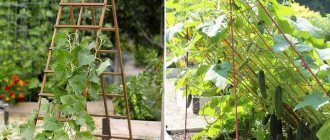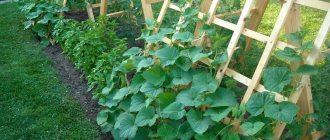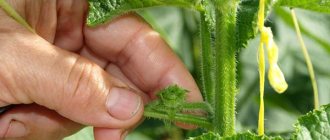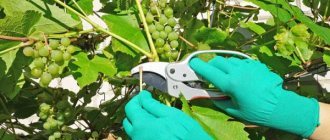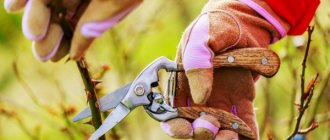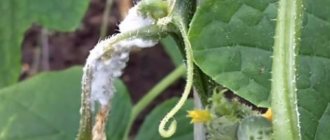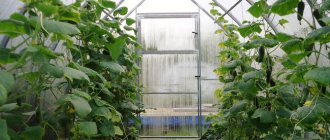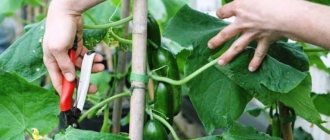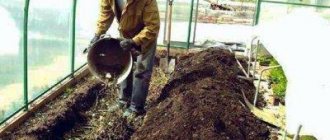Why do you need to form cucumbers in a greenhouse?
Cucumbers are much more comfortable in a greenhouse than in open ground. Here, plants are provided with a stable microclimate, in which natural disasters are not scary. In good conditions, the lashes grow quickly. If cucumbers are not shaped, they will be difficult to care for, but this is not the main reason for the need for pruning and pinching. Forming cucumbers allows you to:
- reduce the risk of pest damage;
- slow down the spread of infections inside the greenhouse;
- save space;
- improve ventilation and lighting of bushes;
- use fertilizers rationally.
This procedure is especially necessary for late varieties. Such plants are prone to the formation of barren flowers. The formation of plants will help reduce the percentage of male flowers.
Prevention of diseases and pest infestations
Injuring the plant during formation will not harm it if the rules for carrying out the work are followed:
- Pinching, pinching shoots and removing leaves is carried out with clean hands and disinfected cutting tools.
- Timely removal of all leaves located below the ovaries improves ventilation and contact with water. Various pests often lay eggs on old leaves, and their removal reduces the risk of spreading to young shoots.
- Leaf blades must be carefully cut and not broken off, as torn edges are more susceptible to infection.
- Formation is carried out in the morning in dry weather so that the wounds have time to dry out during the day. Watering after pinching should be delayed.
- In damp, cold weather, after the formation of cucumbers in the greenhouse, spraying with fungicides is recommended.
How to form cucumbers in a greenhouse into one stem: step-by-step diagram
The formation of bushes with one stem has a positive effect on the size of the fruit - cucumbers become large, since the plants do not waste their energy on the vital activity of the side shoots. This method is suitable for parthenocarpics and hybrids. With this formation scheme, more plants can be planted in the greenhouse. Not only the weight but also the number of fruits increases, and the fruiting period is extended. From one square meter of area you can get up to 15 kg of greens.
Formation scheme:
- the bush is fixed to the crossbar after 5-6 leaves appear;
- remove all stepsons, flowers and ovaries to a height of 50 cm;
- after this, leave 2 ovaries next to every third leaf;
- Closer to the top, 3 ovaries are left near every fourth leaf.
This way an even bush is formed. Removing shoots, flowers and ovaries at the bottom of the shoot is called "blinding". The freed lower tier eliminates contact of the plant with the soil, reduces the risk of diseases, and improves ventilation.
The importance of formation in agricultural cultivation technology
Cucumbers have an increased shoot-forming ability and, if some of the shoots are not removed in a timely manner, a polycarbonate greenhouse can quickly turn into a dense forest.
Growing cucumbers in thickened conditions leads to unfavorable factors:
- Ventilation deteriorates, excess moisture accumulates, which creates favorable conditions for the development of pests and diseases.
- Plants shade each other and neighboring crops, photosynthesis deteriorates and flowering stops.
- The formation of multiple shoots prevents fruit set due to lack of nutrition. The formation of a bush allows you to direct the plant’s forces from the growth of the vegetative system to the formation of a crop.
- By controlling the processes of plant development, it is possible to achieve a favorable diet, lighting, water and air exchange and a significant increase in yield. Properly formed plants are easier to maintain and harvest.
Expert opinion
Stanislav Pavlovich
Gardener with 17 years of experience and our expert
Ask a Question
Important! Timely removal of excess shoots and shaping of the bush allows you to speed up the onset of fruiting and extend its time.
How to properly tie cucumbers
Gartering cucumbers is a rather labor-intensive process. However, this technique helps:
- better preserve the harvest and make it easier to harvest;
- prevent tangling of lashes;
- accelerate the ripening of side shoots that bear fruit;
- make it easier to care for the crop (you can easily pinch it and direct the mustache in the right direction);
- regulate the number of male and female flowers;
- avoid spoilage of fruits and damage by insects.
To tie cucumbers, you need to install a trellis in the greenhouse in advance. For its manufacture and subsequent garter you will need:
- wooden or metal poles 2 m high;
- wire or twine;
- plastic mesh;
- hooks for fixing the mesh;
- wooden pegs;
- strips of cotton fabric 2 cm wide and 20-25 cm long;
- pliers, hammer, nails.
Do not use thin wire or fishing line for work - these materials can easily damage fragile shoots. The bushes are tied up at about a month of age, when the height of the plant reaches 30-35 cm. The timing of tying should not be violated; over time, the elastic stems become harder and can be damaged during fixation.
You can tie cucumbers in different ways:
- Horizontal garter is carried out along the soil level. Most often used in low greenhouses. Metal or wooden supports are dug in on both sides of the bed, and strong twine or wire is pulled between them. The lower tier should be at a height of 25-30 cm, then the steps are placed in increments of 35-40 cm. Instead of wire, you can attach a trellis made of plastic mesh to the posts. You need to secure it so that the bottom edge is at a height of 30 cm from the ground. When the plant grows to the lower tier of the trellis or the edge of the mesh, the main stem is loosely fixed with fabric strips. Subsequently, the side shoots are fixed on adjacent steps.
- Vertical tying is carried out in high greenhouses (more than 2 m in height). The top bar of the structure should be located under the ceiling, and the other should be located below. For convenience, it can be dug into the ground. Stretches of rope are constructed between the slats. In this case, each bush will have its own vertical support, which it will wrap around. Not very tall varieties of cucumbers can be tied to pegs or metal rods driven into the ground.
- The mixed method is used for circular planting of cucumbers. The design consists of 10 metal rods that form a cone between themselves. A mesh is fixed on top of them. Subsequently, the tendrils of cucumber plants are passed into the mesh cells. The shoots themselves begin to weave around the constructed pyramid. The cone is installed before sowing the seeds so as not to damage the young plantings.
It is convenient to use plastic pipes as a vertical support; for reliability, they are dug deep into the ground.
On a note! To prevent the ends of the pegs from rotting in the soil, before immersion they are soaked in a strong saline solution or soaked in gasoline.
Formation methods
There are a lot of methods and associated formation schemes, and new ones are constantly being developed. Let's look at the most popular techniques.
- With garter . Many methods of forming a bush require tying, especially at the initial stage of growth. When attached to a wire, the garter acts as a support throughout the growing season. The garter protects the plant from breaking the stem.
- No garter. For cucumbers with short vines, the garter makes no sense. The plant is able to independently maintain a vertical position.
- On the trellis. It can be wooden and originally designed. You can plant a row of cucumbers, stepping back 25 cm from the mesh or fence, and stretch oblique strings from them to the top of the fence. Over time, the vines will cover the entire fence.
- On a wire. At the ends of the bed, where cucumbers are planted in 2 rows, 2 one and a half meter pillars are buried, 2 rows of wire are pulled between them. A twine is tied to each plant in the first row, thrown over 2 rows of wires and tied to the plants of the adjacent row. The result is a green hut.
- On the grid. The method is very popular among vegetable growers. At the ends of the cucumber ridge, one pipe is buried, and a mesh is pulled over them. Lower shoots and leaves should be removed to improve natural ventilation. As the vines grow, they will attach themselves to the mesh.
- Growing in spread. Cucumbers in open ground must branch. To do this, pinch the main stem. There is no need to do anything else, the cucumbers will grow without formation, forming fruits on the main stem and lateral shoots.
Photo. Options for managing bushes
Pinching and trimming
Pinching and pruning should be done in the morning, according to certain rules - this will help maintain the health of the plants:
- since wounds form on the shoots during the procedure, it should be carried out with hands washed with soap, the damaged areas will need to be powdered with ash or charcoal powder - this will prevent infection from entering the tissue;
- In order for the cut to be accurate and neat, it is better to trim with a sharp knife or well-sharpened pruning shears, otherwise the risk of powdery mildew increases;
- pruning is carried out not only for the purpose of formation, from time to time it is necessary to remove diseased and yellowed vines and some leaves; too abundant vegetative mass requires a lot of nutrition.
Before you start pinching and pruning, you should read the description of the planted variety. For different types of cucumbers, shaping methods can vary significantly.
On a note! It is not recommended to water the plants immediately after pruning - this can lead to rotting of the vines and fungal diseases. Postpone watering until the next day.
What is the purpose of the procedure
The process of forming greenhouse cucumbers into 1 stem is carried out for:
- uniform distribution of load on the root system;
- acceleration of fruiting and extension of its terms;
- avoiding excessive shading;
- timely detection of diseases;
- increasing productivity;
- simplifying care;
- convenience of fruit collection.
Refusal of the procedure will lead to the death of fruit ovaries, deformity of the surviving cucumbers, a decrease in yield and a sharp increase in the likelihood of the spread of diseases.
How to form cucumber varieties and hybrids
For each type of cucumber, experts recommend their own formation scheme, taking into account biological characteristics. Strict adherence to the rules will help you get a generous harvest. Violating the pruning pattern will lead to the exact opposite result.
Parthenocarpic hybrids
Parthenocarpic cucumbers in a greenhouse are formed into one stem - this is the most optimal approach. Stepchildren are pruned, leaving small stumps, as often as possible. The side shoots should not have time to get stronger, due to this, more fruits develop. The mustache also needs to be cut off so that it does not cling to neighboring plants. Formation scheme:
- the lower tier of parthenocarpic hybrids is blinding;
- shoots up to 50 centimeters are pinched into 1 ovary and 2 leaves;
- at a height of 50 cm to 1.5 m, leave 2-3 ovaries and 2-3 leaves;
- Pinch even higher above the 3rd leaf and save 4 ovaries.
It is best to grow parthenocarpic hybrids on a structure in the form of an inverted cone. In such conditions, plants produce a good harvest and receive enough light. Correct formation ensures optimal load on the bush.
Bee-pollinated varieties
Despite the fact that bee-pollinated varieties are not entirely suitable for growing in a greenhouse due to difficulties with pollination, gardeners often plant them, choosing them for their excellent taste, disease resistance, high yield, and the opportunity to get their own seeds.
These varieties are characterized by the formation of a large number of male flowers, so the main stem must be pinched. In this case, side shoots with female flowers will begin to develop.
Features of formation:
- Only the stepsons are removed from the bush, and the ovaries are left;
- the main stem is pinched after 6 leaves form on the cucumbers - this will give impetus to the formation of side shoots;
- From the stepchildren, the 4 strongest are selected and left; it is on them that the main crop will be formed.
It is advisable to leave one bush in the greenhouse with a long central stem. It will produce male flowers, which are necessary for pollination. Sometimes bee-pollinated plants are used to make a so-called cucumber tree. Its crown is formed from the remaining 4 shoots. Each of them is pinched above the second leaf, as a result the crown forms a fork, and 8 lashes will develop on the bush.
Bouquet-type varieties
“Bouquet” cucumbers do not require pollination by bees, so they are often grown in greenhouses. Their peculiarity is that they form not 1-2 ovaries in the sinuses, but up to 10 ovaries at the same time. You can get the entire harvest at one time, which is very convenient for those who do winter harvesting. The purpose of formation in this case is to ensure optimal fruit load on the vine.
Bouquet varieties are grown on trellises with stretched rows of wire. Plants need to be formed into one stem. In this case, the degree of branching of the bush is taken into account. Plants can be weakly branched or densely branched. The second type requires almost no formation. The formation of densely branched varieties has its own characteristics:
- first remove all side shoots at the bottom of the main stem;
- by the end of July, the growing side shoots independently form determinant ones, they are popularly called “bouquet branches”, and a bountiful harvest also grows on them;
- plants are tied vertically, which allows them to be planted on one square meter. m up to 3 plants;
- once a week the main lash is twisted clockwise around the twine;
- after the mother of the main stem reaches the top of the trellis, it is wrapped twice around the wire.
On a note! After fruiting on the main stem is completed, the plant must be fed to give it strength to form “bouquet branches”. As a result, summer residents will receive a double harvest.
Indeterminate varieties of cucumbers
Indeterminate varieties include mainly traditional old varieties of cucumbers. They are distinguished by their tall stature. The main harvest of cucumbers of this type is formed on the side vines, so they require formation into several stems.
How to properly form such a bush:
- the crown of the main shoot is pinched after the 5th leaf appears;
- after this, two lateral stepsons are formed on the plant, they are tied up separately and subsequently sprouted;
- when the stems grow to the top of the trellis, they are thrown over and allowed to grow down, and then cut at a height of 1-1.5 m from the ground surface;
- after this, the bush will begin to actively branch on the side parts and the main part of the harvest will ripen.
Sometimes they do things a little differently. After the main shoot is pinched on the 5th leaf, all side shoots are allowed to develop, shortening each of them after 2-4 leaves appear. The density of the crown is adjusted depending on the cucumber planting pattern.
Basic manipulations carried out during the formation of cucumbers
Garter . Thanks to a well-thought-out garter, you can compact the planting without harming the plants. You need to start when the growing cucumber reaches the first horizontal support. The process must be very careful so that the cucumber does not uproot from the soil. The plant is then regularly wrapped around the trellis. The top should not rest anywhere, that is, it should be free.
Trellis for cucumbers
The side shoots can be tied to the main stem, or they can be attached to adjacent trellises with a deflection angle of 30-35 degrees. This will prevent excess foliage from forming.
Removing leaves . All leaves that touch the ground, that is, the first 2-3-4 leaves, must be cut out. Water gets on them when watering, they age early, etc., therefore, it is better to remove them in a timely manner.
Attention! The leaves should not be broken off, but carefully cut out to avoid the formation of a laceration - a known source of fungal diseases.
Removing side shoots . In another way, the branches are called stepsons and most of them must be removed when forming a bush of varietal cucumbers. This helps to increase the formation of female flowers and earlier ripening of fruits. The stepsons are removed when they reach 3-5 cm. If this is done later, the plant becomes depleted and weakens. Accordingly, the yield decreases significantly.
Attention! There are many varieties known in which ovaries form only on the stepsons. Therefore, if they are removed, there will be no fruit at all.
Pinching . This is the process of removing the top of a side branch, which promotes the formation of 2nd and 3rd order shoots.
The main shoot can also be pinched. This is done in order to stop further growth. It is also pinched when the plant forms 2-3 stems. In this case, more ovaries will form on the side shoots.
Scheme of cucumber bush formation
Advice from experienced gardeners
The formation of cucumbers alone cannot achieve abundant fruiting. Plants definitely need good care. Experienced gardeners share their secrets for growing this crop:
- When purchasing seeds, choose varieties suited to growing in your specific climate. For example, if there are frequent temperature changes and prolonged rains, you can plant varieties such as Cascade, Lotus, Solnechny, Stable, Legend, and Lyubimchik.
- Industrial seeds do not require additional pre-sowing treatment; they already show excellent germination. Don't waste your time on unnecessary manipulations.
- If the root of a cucumber becomes exposed during growth, you should not hill it up. Further watering may cause root rot. Simply mulch the ground with a mixture of sawdust, peat, humus and garden soil.
- Cucumbers love to eat. Chicken manure is an excellent fertilizer for them. As soon as the first true leaf appears, you can fertilize. During the period of active growth, fertilizers are applied every 10 days, alternating organic matter and mineral complexes.
- When tying the lashes, you should not turn them the other way. The plant then spends a lot of effort to turn its leaves towards the sun again.
- If there are a lot of barren flowers on the lash, it should be pinched, this will give an impetus to the formation of female flowers. The pinching may need to be repeated.
Watering and fertilizing
Cucumber needs plenty of regular watering. But stagnation of moisture can cause rotting of its root system. It is very useful to irrigate the green parts of the bush. To do this, you can install an automatic device for drip irrigation. Mulching the soil will allow the soil to retain moisture longer.
Water for irrigation is taken warm; cold water will have a bad effect on the condition of the plantings. After watering, the soil is loosened to prevent the formation of a dry crust. Using a watering can sometimes leads to exposed roots, so from time to time you need to rake soil to them.
The soil in a greenhouse is subject to rapid depletion. Therefore, it will not be possible to grow cucumbers without additional feeding. Regular fertilization will help avoid nutritional deficiencies. But you shouldn’t do this more than 5 times a season. The type of fertilizing is selected depending on the stage of plant development and is applied step by step.
Active growth of seedlings occurs 14 days after planting. At this time, you need to apply a complex fertilizer containing phosphorus, nitrogen and potassium. During the period of mass flowering, bushes need a mixture of nitrogen and potassium; boron and magnesium will also be useful to them. During fruiting, mineral and organic types of fertilizers are especially necessary.
Important!
A constant temperature must be maintained in the greenhouse; overheating of the plantings and lack of ventilation are unacceptable, so ventilation is necessary.
Features of the formation of parthenocarpic varieties
When choosing seeds, pay attention to what type of cucumber variety it is:
- insect-pollinated;
- parthenocarpic (self-pollinating).
The main difference is the female flower on self-pollinating varieties, which has ovaries in the form of a small cucumber. These varieties do not require pollination assistance from insects or humans.
When planting seedlings, prepare twines hanging from above to tie up the bushes. Do not overtighten so that the plants do not pull out of the soil. Wrap the stem loosely around the support, preferably under each leaf, so that in the future it does not break off under the force of the gravity of the fruit.
Remove side shoots, flowers and ovaries from the lower tiers. When the bush reaches 30 cm, pinch the side shoots to 5-6 leaves. Next - above the first leaf of each ovary.
When the cucumber vine reaches the crossbar, it is thrown over and it grows downwards. Pinching is done already on 2-3 leaves. When 1 meter remains between the soil and the vine, it is pruned, stopping growth.
Features of the formation of bee-pollinated varieties
Insect-pollinated plants have male flowers (barren flowers), which are incapable of independently forming ovaries without the participation of bees or humans.
During the flowering period, create access for insects or carry out pollination yourself. To attract bees, make a solution based on honey or jam and spray the bushes.
There is no need to pinch the main stem; it should reach the top crossbar. In the area of the lower 4-5 leaves, all flowers and ovaries are removed. From 5-7 leaves shoots up to 20 cm are left. Then the length is increased. In the area of the crossbar itself, the shoots reach 50 cm. Having entwined the crossbar with the main stem, pinching is done.
Do not allow impenetrable vines to grow. Such plantings are poorly lit, and insect access will be difficult. Insufficient ventilation will cause bush disease.
If there is insufficient pollination of the bushes by bees, pick the male flower and touch it to the female one (it has a small ovary).
Nuances of formation in a greenhouse
Growing outdoors and indoors are very different. In the first case, the bush grows horizontally, in the second – vertically.
With horizontal growth, the vines are located along the ground, and the foliage creates a special microclimate. The pinching process is impractical and will cause bush diseases. To prevent cucumbers from growing too much, it is more effective to pinch the main shoot.
If you observe a large number of barren flowers, pinch out the main stem and partially the side branches. This promotes the growth of second-order branches that will contain female flowers.
Vertical growing is typical for indoor greenhouses. Formation is carried out in one or several stems. As a result, the bush is better illuminated and does not occupy large areas.
Do not forget to ventilate the greenhouse for good ventilation and saturation of plants with oxygen. Provide access to bees and bumblebees that will pollinate cucumber bushes. Water them in the morning, remove dried and diseased leaves.
Tying cucumbers
There are several ways to garter cucumbers. Along with other factors, this also determines how to shape cucumbers in a greenhouse. The tying option should be chosen in accordance with the internal arrangement of the greenhouse and the selected variety:
horizontal. Several tiers of rope are stretched along the entire length of the bed, every 20-40 cm. In this case, you need to ensure that the main shoot does not move along the rope, but redirect it vertically upward;
Horizontal garter of cucumbers- vertical. A trellis is stretched at the top of the greenhouse. A rope with a loop at the end is lowered from it. A stem is attached to it. It will wind along the rope to the trellis. As necessary, more ropes are tied for side shoots;
- v-shaped. Two ropes are tied to the trellis, which are placed on both sides of the bush, and the stem is tied with them;
- net. A net is stretched along the row of cucumbers, along which the cucumber will curl, clinging to the cells with its antennae.
Garter to the mesh
When tying, you need to act carefully. Young seedlings do not yet have a well-formed root and are easily pulled out of the ground when pulled. The bush should not be stretched too much, as this may cause damage to the stem. You can study video tips from experienced agronomists to do everything right.
Features of growing bunched cucumbers
Bundle cucumbers are hybrids developed by crossing several productive varieties with a female-flowering variety. Their large fruit production requires additional care.
The requirements of bunch hybrids for temperature, fertilizing and watering are similar to other cucumbers. But they also have their own characteristics. In particular, bunch cucumbers should not be planted in a draft or too close to one another so as not to thicken the plantings.
Plants need weekly small doses of fertilizing, and mineral and organic fertilizers should be alternated. You also need to pick cucumbers often so that the ripe fruits do not interfere with the development of other ovaries. Growing on trellises will also help increase productivity.
The number of ovaries of bunched cucumbers is adversely affected by excess nitrogen nutrition, overdrying of the soil, severe overheating and excessive shading.
Long and thin cucumbers for pickling
Pencil cucumbers are a new direction in breeding. The agricultural company Manul is actively developing pencil hybrids .
Peculiarities
The main feature is the shape of the cucumbers. They really look like pencils. They grow up to 16 cm in length, do not thicken for a long time, and remain thin and even. In small jars of up to 1 liter, pencil cucumbers are ideally preserved: they are placed vertically, close to each other. It turns out tasty, beautiful and economical.
| TIP: Pick greens regularly to prevent them from overgrowing! |
Magic Flute F1
The parthenocarpic tuberculate hybrid, the first of the “pencil” series, was included in the State Register in 2022.
| Size and shape of the fruit | Smooth, not thick, do not thicken for a long time, remaining thin. |
| Vigor and branching | Tall plants with medium (limited) branching. |
| Zelentsy length | 11–15 cm |
| Coloring | Dark green |
| Taste qualities | Tall, fresh and canned |
| Purpose | Well suited for vertical placement in a jar “under the lid” for canning. |
IMPORTANT
To ensure that all the “pencils” are smooth, without bends or “sharp noses,” feed the plants often, in small doses. Do not apply fertilizers “in reserve”, in large quantities at a time.
Photo: pencil hybrid Magic Flute F1
Pre-planting preparation and its timing
So, first we get the seeds
When purchasing, pay special attention to the information from the manufacturer, which is usually indicated on the packaging. Whichever variety you choose, read carefully to see if processing and preparation has already been done. After all, you don’t want your hard-earned crop to suddenly get sick? Therefore, if you haven’t done anything special with the seeds, prepare them yourself
After all, you don’t want your hard-earned crop to suddenly get sick? Therefore, if you haven’t done anything special with the seeds, prepare them yourself.
It is good to germinate seeds in damp gauze and disinfect with potassium permanganate. But, if it is difficult to get potassium permanganate to disinfect seeds, then use a 2-3% solution of hydrogen peroxide. Heat it to a temperature of 38-40°C and soak the seeds for 7-8 minutes. After this, rinse the planting material well under running water.
Another method is boric acid. Dilute ½ teaspoon of boric acid in a glass of water and soak the seeds in this solution for two to three hours. The optimal solution temperature is 25-30°C. Also rinse the seeds with water.
Ready seedlings (hardened, with four true leaves) are planted in a greenhouse at the age of 25-30 days.
Advantages and disadvantages of cucumbers with limited vine growth
Determinate cucumber species have a lot of supporters and opponents. To understand whether these varieties need to be planted, consider the main characteristics of cucumbers with limited growth.
Advantages of determinate varieties of cucumbers:
- small size of the bush, which greatly facilitates care;
- ease of cultivation in a limited area of a summer cottage;
- simultaneous ripening, which is useful for preparations;
- high quality greens - they do not turn yellow, do not outgrow, are tasty, fragrant, and are stored for a long time;
- cucumbers are good in any form;
- short growing season - due to this they rarely get sick, they simply do not have time to become infected.
The life cycle of many determinate varieties is short; in 2-3 weeks all the fruits ripen; the bush can be removed, freeing up the area for planting greens or other crops. Many summer residents plant determinate varieties to make preparations during abundant fruiting.
Help: these cucumbers do not need to be tied up, trellises built for them, or frequent, regular measures to be taken to protect them from diseases and pests.
As you know, disadvantages are a continuation of advantages. This is exactly the case with determinate varieties. The disadvantages include:
- lower yield than that of indeterminate brothers;
- rapid death of the bush, short life and fruiting period.
Any agricultural technician will tell you that with the friendly growth of the ovaries, plants need abundant regular feeding, so constant and scrupulous care is required during the growing season.
